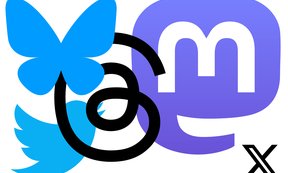Bluesky, Threads, or Mastodon? Following the U.S. elections, many X users are pulling the plug—some of whom had remained loyal through previous waves of departures. The criticism of the platform became deafening after Twitter’s sale and subsequent drastic changes by its new owner. Companies, celebrities, journalists, and many academics have withdrawn. The University of Innsbruck’s communications team, for example, stopped using X a year ago.
But what’s the alternative to this once-popular communication channel? Currently, many are flocking to Bluesky. However, the service is already struggling under the surge of new sign-ups. Its long-term financial sustainability remains uncertain, leaving open the possibility of a fate similar to Twitter’s.
Meta, Facebook’s parent company, launched Threads as an alternative shortly after Twitter’s sale. Integrated with Instagram accounts, Threads’ future trajectory is also unclear. Then there’s Mastodon, which isn’t a platform in the traditional sense. Mastodon is based on a network of independent instances connected through an open protocol within the structure of the Fediverse. The University of Innsbruck has established such an instance, accessible to all staff. Accounts can be created easily via single sign-on.
Building a community on these platforms typically requires significant effort and time. For instance, Twitter hosted a multitude of diverse publics where discussions on science, research, and countless other topics flourished. The platform’s decline has largely dismantled these spaces. It seems unlikely that a single service will emerge to dominate the landscape as Twitter once did. More likely, these new platforms will coexist. This fragmentation has left many wondering where to go next.
This scattered platform landscape is creating uncertainty. The solution could lie in connecting these disparate services. The foundation is already in place, as many of these platforms use protocols that can interact. For instance, Threads in the U.S. has begun integrating with Mastodon, allowing cross-platform subscriptions. Additionally, services already exist to build bridges between Mastodon and Bluesky. Through such connections, Mastodon users can, for example, follow journalists, who recently moved to Bluesky. The University of Innsbruck's Mastodon account is also mirrored on Bluesky via a bridge.
Much work remains before these services can fully interact and create an open microblogging universe for all. For staff at the University of Innsbruck, the Mastodon instance at social.uibk.ac.at offers a service that ensures long-term independence from commercial developments and supports a privacy-friendly social media presence. Early results show that follower counts in the Fediverse shouldn’t be compared with those in the bot-laden world of X. Interaction rates and click-through numbers on Mastodon already surpass those from the former Twitter universe.
The use and promotion of Mastodon reflect the communications team’s broader commitment to open platforms, as outlined in the position paper “Open Science Communication”.
Related articles:

